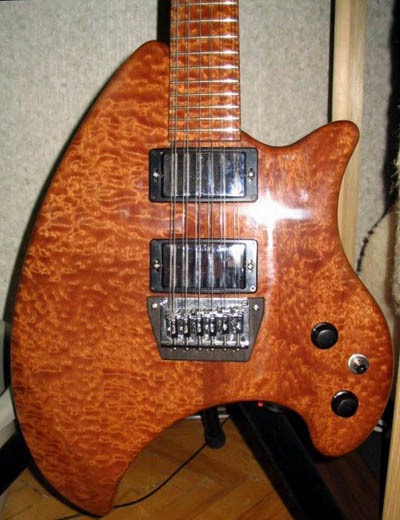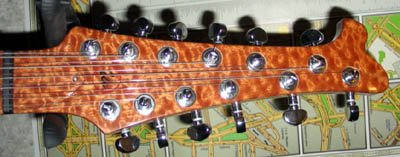Shamray Guitars Reinterprets the Ovation Breadwinner
Custom guitar shop Shamray Guitars took the ergonomic design of the original Ovation Breadwinner (an inspiration for the subsequent Klein Electric Guitar1 and the Forshage hollowbody guitar) and updated it into this 12 string electric guitar made from striking AAAAA figured sapele wood.

For those unfamiliar with sapele, Wood Identification and Use describes it as a type of African mahogany. With wood this unusual, it would have been a shame to hide it behind a pickguard so they did away with it and went with rear routing and a matching control cavity cover.

Other notable differences include the redesigned “alligator” headstock with its straight string pull for tuning stability and a set neck instead of the original Breadwinner’s bolt on neck.

From their site, here are the specs:
- 12-string solidbody electric, 24.0 inch scale length.
- AAAAA Figured Sapele body.
- Set neck – three piece AAAAA figured Sapele neck (opposing grains in each piece, for extra strength) with dual truss rods.
- Figured AAAAA Sapele fretboard (lacquered) with AAAAA figured Sapele headstock overlay.
- No fretboard markers, (for a clean, modern look!) but it does have convenient side dot markers.
- Graphtech nut.
- Chrome 12-saddle hardtail bridge (Gotoh) with ebony surround.
- Grover “Automatic” self-locking tuners (chrome).
- Custom hand-wound Chernishev CCH-12 humbuckers with chrome covers.
- Master volume, Master tone, 3-way pickup selector.
- Vintage bakelite knobs (similar to 70’s Alembic knobs).
- Locking Neutrik jack.
- Schaller strap locks (chrome).
Michael Walker, who designed the “alligator” headstock, has been kind enough to share pictures of the build process so look forward to these in subsequent articles covering the guitar body and neck.
Footnote:
1. ^Klein Electric Guitar – The Klein Electric Guitar is no longer in production. However, you can see examples of builds based on it throughout the site. See PJ Doland’s Replica, Mats Erikson’s Klein Guitar as well as my own project guitar.
And, thanks to fellow guitar blogger JP at Stratoblogster for the heads up on this one.
I’ve seen this one before. I love Breadwinners, but I really dislike that headstock design, it just looks wrong to me.
Actually, since this has a natural finish, shouldn’t it be considered a Deacon rather than a Breadwinner?
No opinion on the headstock shape – I’m a headless guitar kind of guy so I don’t usually give much thought to them. 🙂
I was expecting the Deacon vs. Breadwinner question – I specifically thought of you remembering how much you like this line. I decided on Breadwinner since the custom shop based its work specifically on an image of a Breadwinner.
Hell, just take the ‘snout’ off the gator and it’d look just fine. I like this overall design. Nice wood and finish, too. Really curious what the plain neck feels and sounds like.
Welcome to the blog, Pat! I’ll ask Shamray if they have any recordings…
Is that the output jack socket in the curve of the rear cutaway? Bad move. Early Breadwinners had the socket in this position and Ovation quite quickly changed the location to the front of the guitar on the scratchplate. Who wants a jack plug sticking into their inner thigh when seated? Not very ergonomic, but perhaps it’s what the customer wanted.
Agreed. While some may not think its the most “aesthetic” choice, an output jack on the face of the guitar is out of the way in classical or casual position. I also chose the front of the guitar for my first project.
How the heck did he drill the wiring holes with that setup?
Thomas – would you elaborate?
I have noticed on pictures of used Kleins on ebay and every other guitar with a output jack anywhere on the side, that if there aint a plate, large plate surrounding the output jack (which is only possible on large hollow bodies) there are numerous scratch marks and dents in the paint beside the jack.
Any jack that has been top/front loaded doesn’t suffer from this, because one does not have to GUESS THE HOLE each time by feeling they way with the tip of the tele jack, where the hole is. One “guides” it to the hole first. On the front, you see it and stick it right in in the first shot.
This applies to most guitars though. If it aint visible at all, then your “first shot” hits beside the jack. Making dents and marks in the long run. Actually the Stratocaster way of output jack is the most practical, since it’s not prone to bend or unplug suddenly should you step on your cable. It is – maybe – the least aesthetically looking one, though.
Has anybody been able to find this guitar in Shamray’s Guitar Archives forum thread?
Ray
How’s this for service? – Creation Series CO-12 12 string guitar. 🙂
I’ll be posting “in progress” pictures of the guitar body that aren’t on their forum page for tomorrow’s post so watch out for it.
I am the owner of this bad boy. I must say, I don’t find it particularly ergonomic for playing it sitting down, which is what I do.
Would you care to elaborate?
Since I play sitting down, the lack of an upper horn prevents me from leaning it against my torso like I do with Strat-shaped guitars. Les Pauls give me a lot of trouble too, the Shamray less so because it sits a little higher on my leg and the scale length is 3/4″ shorter. I can only presume the Shamray is about the same as an original Ovation standing up, which I never do, so I can’t comment on that. The Shamray does neck dive, so I assume an Ovation does too. The Shamray may have a few extra ounces in the headstock due to the extra wood and tuning machines, but it does have shorter scale length so it may neck dive no worse than the original Ovation. The lengthy headstock enables straight string pull on all twelve strings, so this baby stays in tune better than other 12-strings.
I find any generally Strat-shaped guitar about equally ergonomic for seated play, and if it neck dives while standing that’s better for sitting because I can angle the guitar up without it sliding off my leg.
By far, the most ergonomic guitar I’ve ever played standing up is a Basslabs guitar because it’s sculpted shape hugs the body in a way you can’t do with wood. Also, the exotic shape enables the guitar to stay stable at 45 degrees while playing. Unfortunately, since I never play standing I can’t exploit this, and the light weight of the Basslab actually makes it less ergonomic for seated play because it wiggles a little. See these links:
http://www.heikohoepfinger.com/
BassLabs USA Guitar
Thanks for all the feedback as well as the links. I’ll take a look at those other designs.
I am curious about how you sit though. The Klein and Forshage are obviously not identical but influenced by the Breadwinner shape. No one has ever called out the lack of an upper horn as a concern. Are you sitting in either a classical position or a traditional position on a suitably tall chair or are you sitting on something like a sofa?
A 16″ high chair so that the knees are the same height or higher than the pelvis, which is best to take unnecessary pressure off the lumbar region, and you can keep your neck and back aligned properly.
The large upper horn–and I have the same issue with basses–enables the instrument to rest against my chest in a way that I can do a “look ma no hands” and the instrument stays stable in my lap while angled from 30-45 degrees past horizontal. That relieves the playing hands from having to support the instrument while they do the fingering. The steeper angle relieves some of the twist you have to do in your left hand to fret the instrument properly. You can’t do that without an upper horn. With a Les Paul, for example, you have to hunch over it and support it with your forearm, and it’s the same issue with the Breadwinner shape, though less so. And even with the extra support, the neck is horizontal to the ground while playing causing the extra bit of left arm twist that gives me excruciating tendinitis in my elbow and shoulder between the anterior deltoid and the biceps. If gone through several six months on/six months off periods with my Les Paul, and at this point I’m sure it’s the cause of my tendinitis. because I keep playing upper-horned guitars during the test periods. I don’t think the arm-twist issue will affect most people, but the bad back alignment required to play a non-upper horned guitar sitting down will alter back alignment for the worse. You know the damage is done when you’ve “gotten used to it” which some people mistakenly think is somehow an indicator of good training, but really means you’ve developed assymetrical back musculature that can sooner or later cause problems the guitarist may or may not know to associate with playing position. This damage can be reversed with the right exercise regimen, but once you’ve got it–which we all get quickly–it’s then up to the luck of your personal biomechanics, which no one knows ahead of time. As a test, look at the standing posture of guitarists who play sitting down: you can tell it’s crap because when standing, as seen from the side, the centers of their ears don’t align with the center of their shoulders, indicating unnatural curvature to their backbone instead of the supportive S-curve humans need; their heads jut forward. Of course, if you’re lucky and never develop debilitating symptoms, then whatever position you use is by definition ergonomic, but people should know that they’re rolling the dice when they don’t inform themselves how to cultivate healthy posture.
On the other hand, I have no issues with 16″ and 17″ hollow bodies. Since the natural playing position supports the guitar in the crook of your elbow, I don’t need to be able to do a “look ma no hands” with a jazz box or a Gretsch. I find a 335 a problem, though, because the way its weight is distributed doesn’t allow me to angle it up a little without it sliding off my leg, forcing me to keep the neck close to horizontal, which my elbow and shoulder won’t tolerate.
[…] a link to a semi-recent Shamray build: Shamray Guitars Reinterprets the Ovation Breadwinner. There’s more on the site showing construction, etc. In the reader comments, the owner provides […]
I have a one pickup Breadwinner that knowone has ever seen before.I also have two Deacons.I gutted the electronics and installed my own,I also added a wonderbar bridge to all three. They are the best playing guitars I have. How can I send you some pics? Also please send me more info on your remake Thankyou Ed Bean (ROADHOUSE)